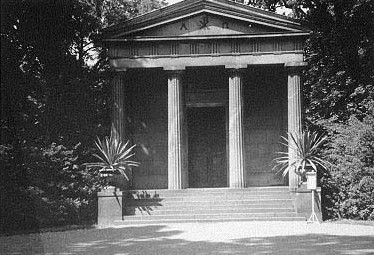Francois Joseph Bosio (Baron)
sculptor and painter; b. March 19, 1768 (at Monaco, France); d. July 29, 1845.
Bosio was a pupil of Pajou in Paris. He is especially known as the sculptor of twenty bas-reliefs for the Colonne Vendôme and the bronze quadriga of the Arc du Carrousel, Paris.
Sir Francis Legatt Chantry
sculptor; b. April 7, 1781; d. November 25, 1842.
The sculptor Chantry made the equestrian statue of George IV in Trafalgar Square (London), the statue of the Duke of Wellington in front of the Royal Exchange, and numerous monuments in Westminster Abbey and elsewhere.
| |
Charles Robert Cockerell
architect and archaeologist; b. April 28, 1788; d. September 17, 1863.
C. R. Cockerell was the second son of Samuel Pepys Cockerell, and in 1809 became an assistant of Sir Robert Srnirke during the reconstruction of Covent Garden theatre, London. In 1810 he commenced a tour of Greece, Asia Minor, Sicily, and Italy. April, 1811, with Baron Haller von Hallerstein (below), architect of the king of Bavaria, Baron Stackelberg (below), and others, Cockerell went to Ægina and excavated the ruins of the temple of Minerva (then called temple of Jupiter Panhellenius). In 1812 they excavated the ruins of the temple of Apollo Epicurius at Bassæ, near Phigaleia in Arcadia. The frieze of this temple was bought by the British Museum in 1813. Cockerell published the results of his investigations under the title The Temple of Jupiter Panhellenius at Ægina and of Apollo Epicurius at Bassæ, near Phigaleia in Arcadia (London, 1860, 1 vol., folio). His studies of the Temple of Jupiter Olympus at Agrigentum were published in 1830 with other monographs by W. Kinnard, T. L. Donaldson, W. Jenkins, and W. Railton in a volume supplementary to the Antiquities of Athens by Stuart and Revett. He was appointed surveyor of S. Paul's cathedral in 1819. About 1830 he began the National Monument in Edinburgh, which was never completed. In 1833 he succeeded Sir John Soane as architect of the Bank of England. He was elected associate of the Royal Academy in 1829, and in 1836 Royal Academician. From 1840 to 1857 he was professor of architecture at the Royal Academy, London. In 1847 he succeeded Harvey Lonsdale Elmes as architect of S. George's Hall, Liverpool. His designs for the sculpture of the pediment of this building were published in the papers of the Royal Institute of British Architects (1863-1864). Cockerell was president of the Royal Institute of British Architects in 1860-1861, Chevalier of the Légion d'Honneur, member of the American Institute of Architects, etc. He was buried in S. Paul's cathedral. Much of his success was due to his skill in drawing the human figure.
| |
Karl Haller von Hallerstein
architect; b. 1774.
He was Bauinspektor at Nürnberg, Bavaria, and in 1810 went to Greece, where he was associated with C. R. Cockerell (above) in his excavations at Ægina and Phigaleia. It was through his agency that the sculpture of the pediments of the temple of Athena, at Ægina, were secured for the Glyptothek, in Munich.
Magnus Freiherr von Stackelberg
architect; b. 1787; d. 1837.
Educated in Dresden, and from Dresden went to Rome, and in 1810 to Greece, where he assisted in the excavation of the temple of Athena at Ægina and the temple of Apollo at Bassæ (see Cockerell, C. R. above). He published Der Apollo tempel zu Bassæ in Arcadien (Rome, 1820, folio), and La Grèce, vues pittoresques et topographiques (Paris, 1834, folio).
| |

Karl Friedrich Schinkel, Mausoleum of Queen Luise (Berlin: 1810-1840).
|